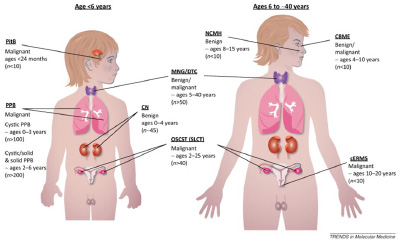DICER1 Syndrome
View other pituitary disorders
Pituitary tumours arising under the age of 2 years could be caused by the DICER1 syndrome. Most often these present due to symptoms related to the pressure caused by the tumour on the surrounding tissues but the tumour can secrete ACTH causing cortisol excess leading to Cushing's disease.
What is the DICER1 syndrome?
The DICER1 syndrome, also called pleuropulmonary blastoma familial tumour or dysplasia syndrome, is a familial disorder that causes a predisposition to develop different kind of tumours.
The most common expression of this syndrome is the presence of tumours in the lungs in up to 50% of the patients, so called pleuropulmonary blastomas. Other tumour types have been described in other organs like ovary, kidney, uterus, thyroid gland, eye, nasal cavity, connective tissue and pituitary gland, some of them malignant. However, this is a novel syndrome and researchers are studying other potential tumours.
Each tumour in the syndrome has typical age of presentation ranging from infancy to the second or third decades of life and many of them may be bilateral.

Which is the cause of this syndrome?
This syndrome is caused by a mutation in a gene called DICER1. This gene is inherited in an autosomal dominant manner, which means a person could get the disease when inherit an abnormal gene (mutated) from one parent. In other words, given that most of cells have two copies of each gene, one from the mother and one from the father, a person who has the mutation in one copy of the gene is at risk to develop this syndrome. However, 20% of the patients have a new mutation that is not inherited.
How frequent is the DICER1 syndrome?
The frequency of DICER1 syndrome is unknown. In general, all the tumors associated with a mutation in gene DICER1 are rare, with the exception of thyroid gland tumor. For example, about 25-30 cases of pleuropulmonary blastomas are reported every year in USA, and only 13 cases of pituitary blastomas have been reported as related to this syndrome.
How can the DICER1 syndrome be diagnosed?
The diagnosis of DICER1 syndrome is suspected based on clinical findings. This should be confirmed by a genetic test, to study a mutation in the gene DICER1. When this syndrome is suspected, is recommendable to confirm the diagnosis with the presence of a mutation.
Who should be tested for the mutation?
When an affected member of a family is diagnosed with a mutation in DICER1 gene, the genetic test could be offered to the family members who are at risk. Not all the members in a family have the same risk to present the mutation, depending on the kinship degree.
What is the treatment of this syndrome?
The treatment of this syndrome depends of the type of tumor presented. Generally, the treatment involves the surgical resection of the tumor, and sometimes chemotherapy or radiation.